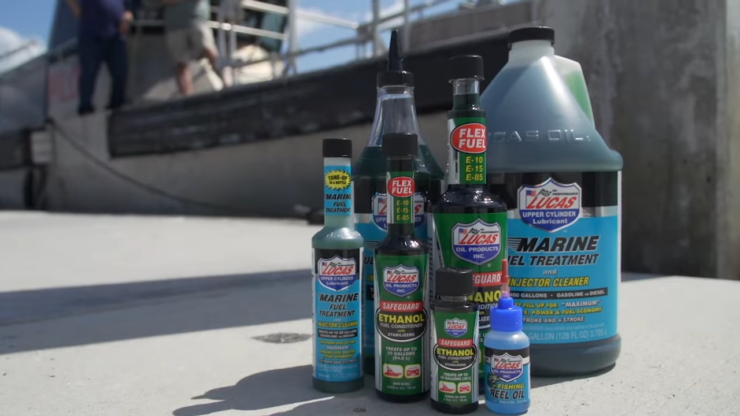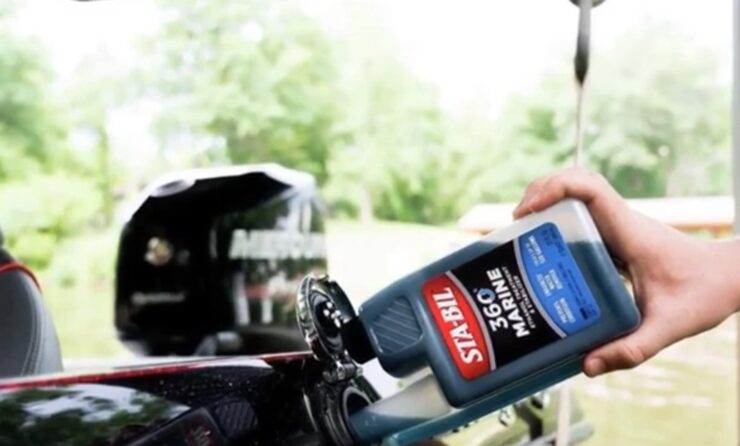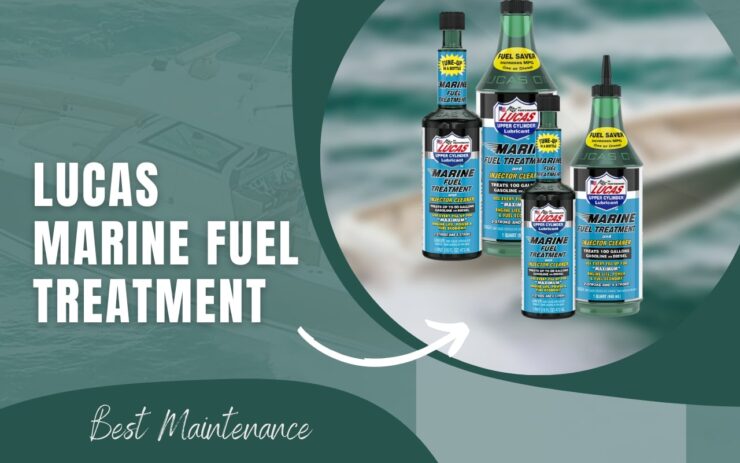If you’re a good boat owner, you should maintain a regular upkeep for it. However, hiccups arise in the engines for each and every cruiser. No matter the weather, your boat’s fuel system requires treatments to fight corrosion.
Lucas Marine Fuel Treatment is specifically designed to address the issues that watercraft owners have with their engines and fuel systems. It prevents corrosion, cleans and protects fuel lines, carburetors, and fuel injectors, and lubricates and protects critical engine parts.
Powerful detergents, such as polyether amines, improve fuel systems and internal engine part cleanliness. It’s designed for gasoline and diesel engines, 4-stroke or 2-stroke. Upper cylinder lubricants insure smooth operation and longer engine life
You might have seen Lucas’ marine fuel cleaners at the fishing store. As an enthusiast you might be curious whether you should pick one up for yourself.
So, is the Lucas Marine Fuel Treatment any good?
Absolutely! It’s designed with deep saline corrosion protection. Deposit removal, long term lubrication, better fuel economy and easy application are the unbridled benefits. Maintenance, cleaning and fuel stabilization using this include slightly different procedures though!
Still not convinced about the benefits of the fuel treatment? Don’t worry. This article glazes over the benefits and the simple application process.
Keep reading for the details!
Table of Contents
ToggleHow Does Lucas Marine Fuel Treatment work?

The fuel for your boats often contains ethanol. Ethanol build up in the metal lining often causes water to stick and react. This is because water and ethanol intermix molecularly through hydrogen bonds.
The build-up which reacts with the air and lining causes multiple types of corrosion. This is done through oxidation, which also causes rust in iron.
Gunk from the combustion in the form of soot can also build up in the chambers. The valves can also be affected. Faulty combustion also breaks the surge linings of the boat engine. The ethanol corrosion is handled through the detergents which cancels the reaction.
The gunk is removed by the dissolution of soot through the same detergents.
Last but not least the faulty combustion is taken care of through the lubricants present.
It helps the lining remain smooth and non reactive to the occasional incomplete combustions. But how do you apply the treatment itself? Read on!
How to Apply Marine Fuel Treatment

Applying fuel treatment is rather simple if you have a firm grasp on the details. Depending on the purpose for the addition of your fuel treatment, the procedures are varied. Properly applying it can resolve different issues such as problems with volvo penta fuel pump.
However, you can add the fuel treatment for maintenance, cleaning or stabilization. Let’s get started!
Maintenance
If you’re adding the fuel treatment for regular maintenance, the procedure is rather simple. Fuel system or engine maintenance requires precise additions.
But a general rule of thumb is one per one and a half. Meaning that you add 1 ounce per every 1.5 gallons of gasoline. 1 can of Lucas Marine Fuel Treatment treats up to 30 gallons of gas.
Simply add after refueling the boat. Make sure the fuel you apply the treatment to is maintained at a low temperature. This prevents the coagulation of the two liquids, which can build up gunk.
Cleaning
For cleaning, the details are a bit more specific and down to the size of the boat. For boats with 4 stroke engines, you have to add more treatment than ones with only 2.
With the rule of thumb out of the way, let’s get into the numbers. You need to add 2 or more ounces per gallon to a partial tank. Which is sometimes also called a low tank. Essentially the more you add, the cleaner the fuel gets.
If you opt for professional cleaning, use a 50/50 mixed ratio with gas. This is to remove all the gunky suspensions in the fluid. It also helps on removing gas from boat fuel tank
If you’re cleaning the fuel filters, make sure to spray with some aerosol treatments first. These usually come in cans. The same procedure is also used for priming the fuel injectors and filters.
Stabilizing
Stabilizing the fuel with a treatment may seem straightforward, but this involves some heavy calculations. Get your pen and paper and a calculator out!
For 2 stroke engines, you have to add 2 ounces per gallon, with an aerosol pre-mix. But this is only for the first 1000 miles of use if your boat is fairly new. You slowly add a quarter of an ounce more each time for each of the next 1000 miles.
This means you increase the amount to 2.25 ounces per gallon. Then 2.5 ounces for the next 1000 (upto 3000 miles). As the engine loses some malleability, this enables proper thinning of the fuel with time.
But you can avoid this hassle by using a ready stabilizing fuel mix. This only requires 1 ounce per gallon each time. You can use the aerosol treatment too!
Benefits of Lucas Marine Fuel Treatment

The Lucas Oil brand is a namesake endeavor in the marine auto industry for years. Lucas Marine Fuel Treatment helps your engine start faster and run smoother.
Thoughtful maintenance is the primary focus of the fuel treatment. Both gasoline and diesel marine propulsion systems benefit from treatments that are listed below.
Fights Corrosion
The fuel for your boats often contains ethanol which builds up in the metal lining. The fuel treatment stops this using its detergent additives.
It cures the effects of the corrosion or rusting inside, but doesn’t cure the ethanol itself.
Designed for Watercraft
The marine fuel treatment was made with watercraft engines in mind. The solvency for the fuels is designed with specifications usually found in boats.
The 2 or 4 stroke engines benefit greatly with thinned fuel. Which is made possible by the treatment.
Better Fuel Economy
The treatment works its way through the fuel injectors and safely removes deposits from carburetors. It also removes harmful engine residues from fuel passageways.
The deep clean enables for complete combustion of the fuel at a higher percentage. Meaning less fuel is wasted, giving you better value.
Clean and Clear
The detergents such as polyether amines improve the internal engine performance. It clears fuel lines and keeps the injectors safe from lacerations caused by faulty combustion. Lubrication keeps the vital engine parts squeaky clean when drained of fuel.
Reduces engine deposits
The fuel treatment helps clean and remove deposits that build up in the fuel system and engine over time, resulting in smoother operation and reduced engine wear.
Easier starting
The product improves the ignition process, making it easier to start the engine, even in cold weather conditions
FAQs
How often should I use marine fuel treatment?
You should use cleaning treatments for boats every time you change the oil. The majority of fuel injector cleaners recommend being used every 3,000 nautical miles or at every oil change. If you have a new boat, you can go longer without marine fuel treatment.
What happens if I use the fuel treatment too frequently?
Depending on the detergent strength, you can damage the engine if you treat it too often. Using it every time you fill up or change the oil of the boat is recommended. But too frequent a use actually damages the engine lining. This can in fact lower the engine performance and fuel efficiency.
How much does Lucas Marine Fuel Treatment Cost?
Lucas Marine Fuel Treatment can cost roughly $70 per gallon. A gallon has a 33 pound net weight. It is very worthwhile as they also offer a 5oz bottle for $19. You can pick this up from any of your local hardware or fishing stores.
Is Lucas Fuel Treatment good for your engine?
Yes, Lucas Fuel Treatment is generally considered to be good for your engine.
It is formulated to improve the performance of gasoline and diesel engines, and is said to provide better fuel economy, reduce engine wear, and reduce emissions.
It is designed to help clean and lubricate the fuel system, which can improve engine performance and reduce the risk of breakdowns.
It is important to note that Lucas Fuel Treatment should be used as directed and should not be used to replace regular maintenance.
When should you use fuel treatment on boat?
How long does fuel treatment last?
Final Words
We hope you have a better grasp on the need for Lucas Marine Fuel Treatment. It’s simply great value for the buck.
Protecting your boat from sea water damage or just rust is very important. And clogs made soot in any form is bad news. Taking care of these issues is made simple by Lucas. Make sure your boat maintenance knowledge is always up to date.
Keep your engine in olympic shape and thank you for reading!
I’m Liam Jackson, the proud owner and driving force behind KayakPaddling.net. Born somewhere in the expansive beauty of the United States, I’ve nurtured a lifelong passion for kayaking and fishing that has led me to explore the far corners of our nation’s waterways.
Related Posts:
- Heavy Duty Fishing: 11 Best Rods And Reels For Big Fish 2024
- 15 Best Baitcasting Reel Under $100 2024 - Improve…
- 16 Best Kayak For Beginners 2024 - Kayaking Adventure Gear
- 17 Best Trolling Reels 2024 - Enjoy your Fishing Adventure
- 10 Best Saltwater Fishing Boats - Ultimate Angling Adventure
- 10 Best Inflatable Paddle Board 2024: My Top 10 iSUP…












